
Vivid Recollections
Lights On at Vivid Sydney: jaw-dropping light installations are only an extension cord away.
Text:/ Tim Stackpool
In the space of only three years, Vivid Sydney has become a much-anticipated winter festival of spectacular light, music and ideas, spread across 18 days. Immersive projections on the Sydney Opera House sails, performances from local and international musicians as part of Vivid Live and a free outdoor exhibition of light sculptures, all contribute to the event.
While the festival includes many public talks, debates and discussions among leading creative thinkers from Australia and around the world, the public display of light sculptures around the Sydney Harbour foreshore precinct attracts hundreds of thousands of visitors, and present the organisers with almost as many challenges. Developed with Events NSW, AGB Events principal, Anthony Bastic, partnered with some colleagues after seeing similar events in Europe. Together, they developed the Sydney light sculptures concept (and more) with the various state authorities.
‘Lights On’, as the sculpture exhibition is called, is produced by Laura Roberts, with the prep work starting with compiling an invitation list of lighting designers and companies from around the world. These designers are asked to make a submission, based on an expression of interest (EOI) document framed by AGB’s production manager Peter Loxton. “They were asked to submit a 250-word synopsis of their concept along with detailed installation plans, power requirements and safety issues,” Laura Roberts said. “The process required artists to really think through their submissions.”
From those approached, the AGB team received 60 submissions, most of which made the grade. A selection panel made up of Events NSW, AGB, their technical advisor and the exhibition curator reduced the number to a shortlist of 35 who were then required to present their intention to the panel. “The technical and physical considerations were that the event was outdoors at the beginning of winter, had to be in place for 18 days, accessible to the public and could stand up to the wear and tear of the visitors,” Laura Roberts said.
PICKING WINNERS
Finally, 24 artists were selected to exhibit at Vivid, including six international artists from Singapore. Apart from these, five major works were commissioned for the event, including the illumination of the Opera House by Superbien, Customs House projections by The Electric Canvas, Fire Dance by Howard & Sons Pyrotechnics, an interactive ‘Paint’ projection by Spinifex Group at the Museum of Contemporary Art, and the lighting of the ‘dress circle’ of buildings around Circular Quay by 32 Hundred Lighting.
For production manager Peter Loxton, the early priority was on delivering the event safely, on time and within budget. “The EOI was an important piece in this puzzle,” he said. “It was worded in a way that placed a great deal of ownership onto the artist, which included engineer’s certification if required, Safe Work Method statements, public liability insurance for anyone working on site, work zone areas marked off with cones, tape and bollards, as well as appropriate clothing, being high visibility vests, correct footwear and such.”
The bump in and out periods were identified as potentially the most risky times. AGB had five site managers, each responsible for monitoring the activities within an allocated zone. The site managers would carry out a full site induction before issuing coloured wrist bands as a form of ID.
Notwithstanding the attention required to achieve the installations smoothly, AGB needed to also keep a handle on artist management, ensuring they deliver on-time and to the standard described in their submission [see my comments on the success of this process – Ed]. Landowner management also presented a challenge. Working within The Rocks and Circular Quay public spaces can involve liaising with up to five different landowners, both government and private, for just one exhibition site. Each had their own processes for attaining permission to access their property. Additionally, the artists had to be made available to the media, and regular meetings with Vivid Live and Creative Sydney ensured that the festival met the expectations of the client, Events NSW.

FINDING A SPACE (& A POWER POINT)
For the producer Laura Roberts, the balance between technical necessity and artistic temperament was a consideration. She told AV: “Most of the artists already have in mind the exact location they want their installation to be set up in. And they usually all select the same location! We also need to meet the client’s expectation, which is to spread the light installations throughout The Quay and The Rocks, finding little pockets or alleyways which encourage the public to explore areas they might not otherwise know about. After many walk-throughs and hundreds of maps drawn, once we settle on a location we would then identify the landowner, obtain permission and if required, locate the nearest power source”.
The flow of pedestrian traffic around the artworks also needed significant thought. “For example, have we created bottlenecks? Can people safely gather around the installation? Does this meet the requirements of our Risk Assessment and Emergency Evacuation Plan? We essentially needed to please the artist, Events NSW and finally make sure it’s all feasible from a production standpoint. The ‘aLf’ piece down at First Fleet Park took months of work to get to that point!” Laura said.
FIREFLIES SOCIALISING
Of the sculptures presented at Vivid 2011, one stands out as having particular impact on the production crew, not just because of its innovative nature, but also because of the public’s response. Social Firefly was presented to the selection panel as a new design concept, described by the artists as a social structure of friendly lights. The Vivid selection panel commissioned Liam Ryan and Jason McDermott (of Arup) and Frank Maguire to create the artwork, engaged by the possibilities of public interaction with this artificial social network. It became one of the most immersive and interactive installations of the festival.
Billed as a creative exploration of social network theory, the work involved a Moreton Bay Fig tree inhabited by a colony of 50 fully autonomous ‘Fireflies’; electromechanical devices equipped with ‘eyes’ built from light dependent resistors, an 8-bit industrial microcontroller for a ‘brain’ and a servo-driven LED MR16 light source as its ‘tail’. Each Firefly was able to react to the light sources around it, including from the environment, its neighbours and from people with torches. This worked in combination with interaction algorithms developed to mimic artificial life. The result was that the more connected fireflies were highly influential and influenced more easily, while isolated fireflies had to work harder to make an impact on their friends.
As Jason McDermott, one of the artists put it, “We were genuinely surprised by how much people wanted to interact with the fireflies, choosing to clap, scream and wave at the artwork, even when it was purely light based. The artwork was an illustration of emergent behaviour, not only through the light patterns of the fireflies, but also the interaction behaviour of visitors to the festival!”
Another installation popular with the crew was ‘Public Art Pencil’ by Brisbane based artist Paul Johnson. Public Art Pencil was a 3m-long ‘pencil’, being made of metal containing two Oracle lasers that allowed the public to draw onto three large panels that hung from the side of a building, somewhat like an oversized ‘Etch a Sketch’.


HERDING CATS
Given this is Vivid’s third year, one might hope the logistical solutions and infrastructure used previously might make for an easier rig in subsequent years. Not so, says Peter Loxton. “While the aim is the same – to deliver an event that will attract people into the precinct – there was no workable template to deliver ‘Lights On’ for Vivid 2011. Our previous experiences gave me an understanding of what was or wasn’t possible, but we couldn’t begin to map out the structures until we confirmed the final list of installations. It then takes numerous meetings, both on and off site to establish the final destinations of every installation and associated information light boxes.”
For each installation consideration has to be given to such matters as whether the sculpture is interactive and requires public access; the relationship between the sculpture and the surrounding spaces, other nearby installations and the other public uses of the location; the availability of power; the exposure of the installation to the elements; vehicle and machinery access for delivery and installation and removal; and because of the locale, the impact of the installation on heritage buildings and locations.
The list of landholders who were required to give access to their property for the 2011 event included, Sydney Harbour Foreshore Authority, City of Sydney, Opera House, Sydney Ports, NSW Maritime, Railcorp NSW, Roads & Traffic Authority, Sydney Ferries, Opera Quay, Bennelong Apartments, National Parks and Wildlife, Overseas Passenger Terminal, Rocks tenants, Circular Quay tenants and Alfred Street tenants. That’s enough red tape on its own to strike fear into the heart of any event organiser.
IN FOR THE LONG RUN
Technically, once in place, the sculptures required little maintenance, as the endurance of each work was a significant requirement at the pitch stage. The durability of the piece at the hands of a curious public was a major consideration, as was weatherproofing. In 2010, the event suffered rain for 19 of the 21 nights. Again this year, all external electrical components were rated IP66 (which is proof against water jets, not immersion), had to be tested and tagged, and approved by the relevant authorities.
Sourcing power only proved to be trying in a couple of instances. “In general it wasn’t a huge problem as most of the installations only required a standard general purpose outlet,” said Peter Loxton. “There were a few that were quite a challenge to arrange, mainly due to the various landowners. Some locations took literally weeks of calls, emails and meetings to even establish which landowners were responsible for the power source. The Argyle Cut for example, has six different parties who all have some ownership or responsibility for an installation in this space. I’m proud to say that no generators were required to power any part of the exhibition. The biggest challenge was to keep the installation at its desired location but keep the power cable runs, in particular cable trays, to a minimum; not from a cost perspective, but simply from the look and safety aspects.”
During the event, AGB site managers would conduct visual maintenance inspections of every installation at least three times per night. Security teams were also required to report any issues or concerns they had to the site managers. The various crews provided an additional set of eyes. Problems relating to the local power were addressed by the technical crew, who were on site every night. Any problems relating to the installation themselves were reported to the artist immediately. ‘Out of order’ signs were used to inform the public that a particular installation was not working. Only a couple of installations failed during the event due to local power failures, and even this was restored within an hour in one instance, and within 15 minutes for the other. Some installations did require daily cleaning or expected maintenance, which was flagged before the event began.
VIVID WASHUP
Vivid is certainly a unique production, not only within Australia, but also around the world. “It’s like the Biennale festival: an interesting clash of art and an outdoor environment, but with the added bonus of light,” Peter Loxton said. “Creating a light playground for thousands of people to enjoy makes all the hard work worthwhile. The bonus is working the nights as you get to experience first hand this enjoyment.”
In 2010, Vivid was visited by 300,000 people to the exhibition. The goal for 2011 was to raise that by 100,000. In fact, while crowd numbers for this year officially reached the target, unofficial estimates put the figure much higher. And while any display of public art will attract both praise and criticism, the attendance numbers have made Events NSW very happy indeed.
VIVID REPORT: “MUST DO BETTER”
Perhaps I’m not entirely typical of the punters who visited Vivid; but unaccompanied by the PR minders who are usually assigned to members of the media, I took a stroll round the Rocks and Circular Quay area one cold winter’s night, to have a look at the artworks. I was immediately impressed by the lightboxes (obelisks?) that were located near each artwork. These displayed some text about the artwork, a mini-biography of the artist, the obligatory logos of all the sponsors and a map of the locale, showing the positions of nearby works.
For many of the works this helped to explain the artists’ ideas and often gave hints as to how an artwork was intended to be viewed or interacted with. Unfortunately in several cases the obelisks were more meaningful and better presented than the artworks they accompanied.
Please don’t dismiss my remarks as merely coming from some art Philistine who was a hard-bitten lighting tech for a few decades. I’ve also designed the lighting for hundreds of live and video productions, art installations and performance art works. I have many friends who are visual artists, and through collaborating with them and through teaching production technologies in an art and design school and an arts academy, I’m quite familiar with the language and dialectics of the visual arts.
Given this background I wasn’t baffled by the art rhetoric that accompanied each work, but I was frequently dissatisfied that the work fell a long way short of the promise contained in its curatorial description. Sorry, but bunging a few lights haphazardly around a historical building isn’t about ‘teasing out the historical context’ of the building or ‘hinting at its many moods’.
I was initially angered when I came across one piece that used solar cells to charge up during the day, then run for about a half an hour after sunset before ceasing to perform at all for the majority of the night. I thought that I had been cheated of an opportunity to see this work in action, until it later dawned on me that I had seen it in all its glory. The work was actually a great big raised middle-finger to all the stupid punters like me, who came expecting to see a performing artwork. What we had to do was imagine what it would have been like if the sculpture had stored enough energy to actually work.
As a punter I was intrigued by quite a few of the pieces, baffled at the artistic meaning of others, impressed by the clever technology and ideas in the Fireflies, mildly amused by some of the graphic designs projected onto the Opera House sails by the now-traditional cluster of Christie projectors, absolutely sucked in by the Howards’ fire show, and finally surprised at how hard it was find a cup of coffee near the Lights On show at 10:30 on a Tuesday night in Sydney. Mostly though, I was disappointed by the number of ill-conceived and poorly executed artworks which clearly failed to live up the promise of their submissions to the selection panel. Vivid obviously needs to bring in the Arts branch of the ACCC to ensure that the artists deliver on their promises to the public.
– Andy Ciddor

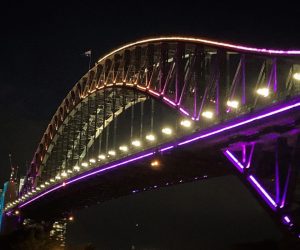
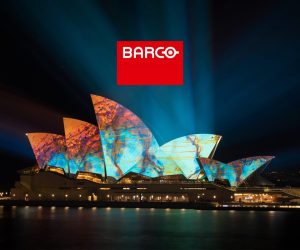
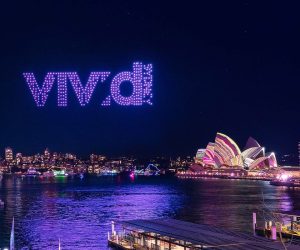
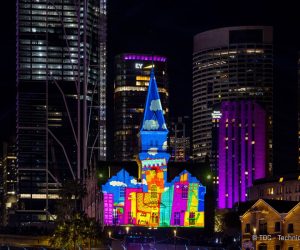
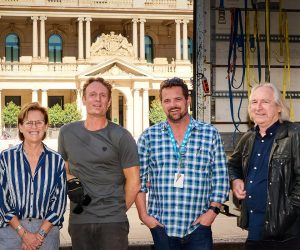
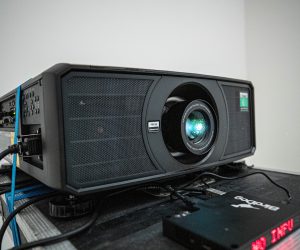
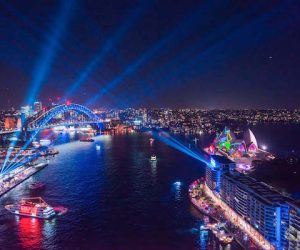
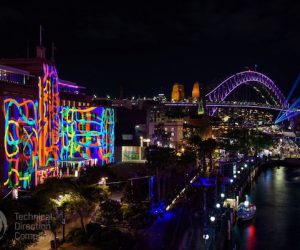
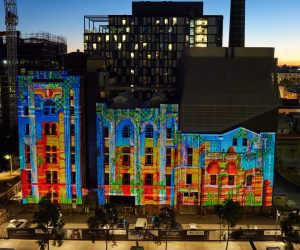
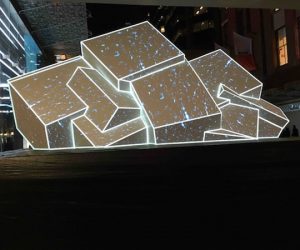
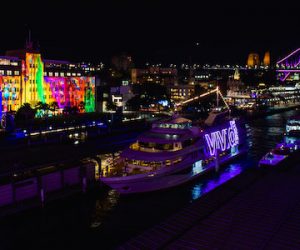
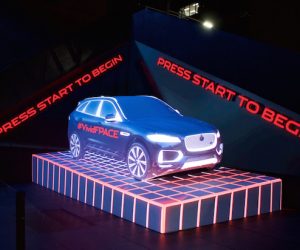


RESPONSES